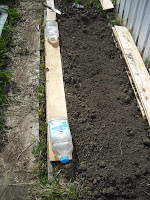Confession: I spend more time intentionally destroying plant life than enabling growth. It seems that way, at least. This weekend I spent maybe an hour preparing beds, sowing, transplanting, and watering. Many more hours were devoted to battling the most vigorous crops of early May - dandelions and quack grass. It's deja vu all over again. Last summer was consumed by "weeding", a euphemism for killing unwelcome plants, and I promised myself that next year would be different. Promise unkept. But it's early in the season yet.
 If only I could learn to like quack grass, how happy I would be, and how successful I would feel. The large, wide, soft blades grow quickly in the spring and spread rapidly by underground rhizomes. It's a lush grass, especially at this time of year when so few species are making serious contributions to the landscape. If a cow wandered into our yard she would salivate at the site of these generous tufts. If left alone, the grass would gradually succumb to ecological succession as other species replaced it. My big problem with quack grass is not its competitive spirit, but those rhizomes. A blade emerges in the middle of a patch of tiny carrot tops and I don't dare to pull it for fear of the entire rhizome network coming with it and disturbing the carrots. Yet, if left there, it becomes a shade-creating, water hogging competitor as well as an energy source for the rhizomes as they tunnel onward toward the beets. One preventative measure started yesterday was to cover the bricks that surround our garden beds with lengths of board in an attempt to starve the vegetation to death. It first required some work to dig out roots so the board could lie flat on the bricks, but one small section is now in darkness. It's a risky investment of time; I did have better things to do. If only I could trust the killer chemicals.
If only I could learn to like quack grass, how happy I would be, and how successful I would feel. The large, wide, soft blades grow quickly in the spring and spread rapidly by underground rhizomes. It's a lush grass, especially at this time of year when so few species are making serious contributions to the landscape. If a cow wandered into our yard she would salivate at the site of these generous tufts. If left alone, the grass would gradually succumb to ecological succession as other species replaced it. My big problem with quack grass is not its competitive spirit, but those rhizomes. A blade emerges in the middle of a patch of tiny carrot tops and I don't dare to pull it for fear of the entire rhizome network coming with it and disturbing the carrots. Yet, if left there, it becomes a shade-creating, water hogging competitor as well as an energy source for the rhizomes as they tunnel onward toward the beets. One preventative measure started yesterday was to cover the bricks that surround our garden beds with lengths of board in an attempt to starve the vegetation to death. It first required some work to dig out roots so the board could lie flat on the bricks, but one small section is now in darkness. It's a risky investment of time; I did have better things to do. If only I could trust the killer chemicals. Dandelions began rearing their deceptively pretty heads a few days ago. It makes them easier to find on the lawn and instills a sense of urgency approaching panic. It almost flashes a countdown, akin to a pedestrian traffic signal, to the moment when the yellow head turns to fluff and sets off to conquer new lands that are not far enough away. The pointy right-angled extraction tool makes removal somewhat easier, if you don't mind having holes all over the place, but it's still hard to keep up with them. I also feel some ambivalence about removing the plants rather than making daily rounds of flower-picking. It seems that some ground nesting bees like to dig their nests under the spreading leaves of plants like dandelions, which provide some protection from the elements and from predators. Who in their right mind would deny a good home to a bee? Being a steward of the earth is not an easy gig.
Dandelions began rearing their deceptively pretty heads a few days ago. It makes them easier to find on the lawn and instills a sense of urgency approaching panic. It almost flashes a countdown, akin to a pedestrian traffic signal, to the moment when the yellow head turns to fluff and sets off to conquer new lands that are not far enough away. The pointy right-angled extraction tool makes removal somewhat easier, if you don't mind having holes all over the place, but it's still hard to keep up with them. I also feel some ambivalence about removing the plants rather than making daily rounds of flower-picking. It seems that some ground nesting bees like to dig their nests under the spreading leaves of plants like dandelions, which provide some protection from the elements and from predators. Who in their right mind would deny a good home to a bee? Being a steward of the earth is not an easy gig. At last I put a deadline on destruction: "At two o'clock, I will put down the shovel and do something constructive". By the end of the day the lattice above the greenhouse entrance was in place, a task I did not find the time for last year. The grapevines have something to reach for now. This felt like success, and I'm quite motivated to feel that again.



I thoroughly enjoy reading this Heather - black thumb; green heart; golden pen!
ReplyDelete